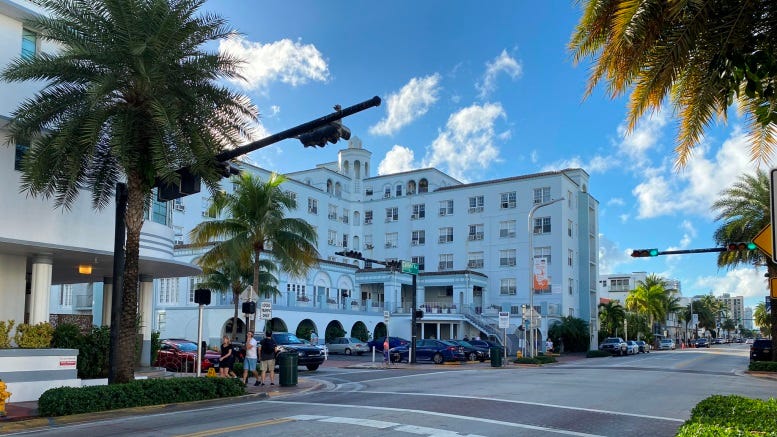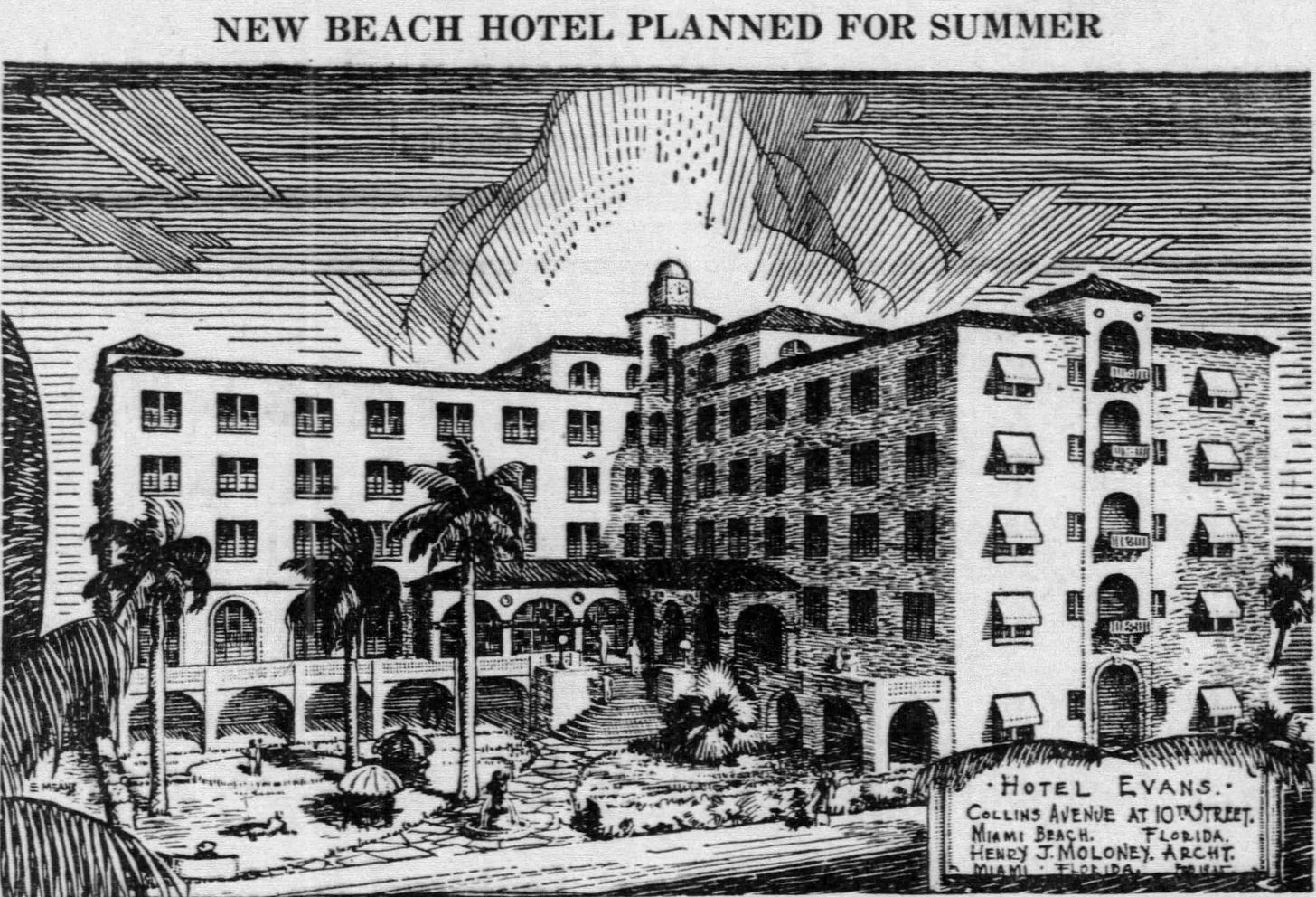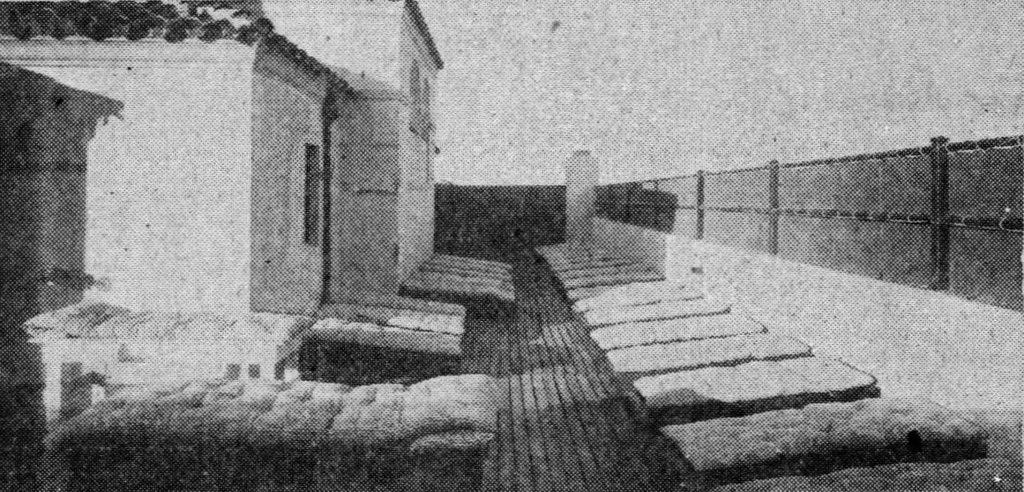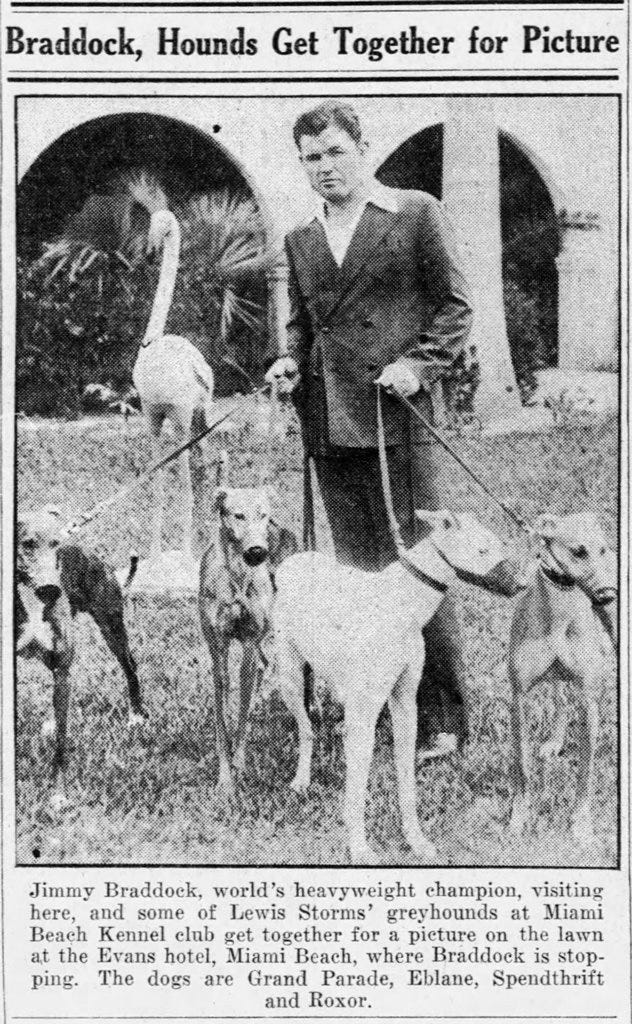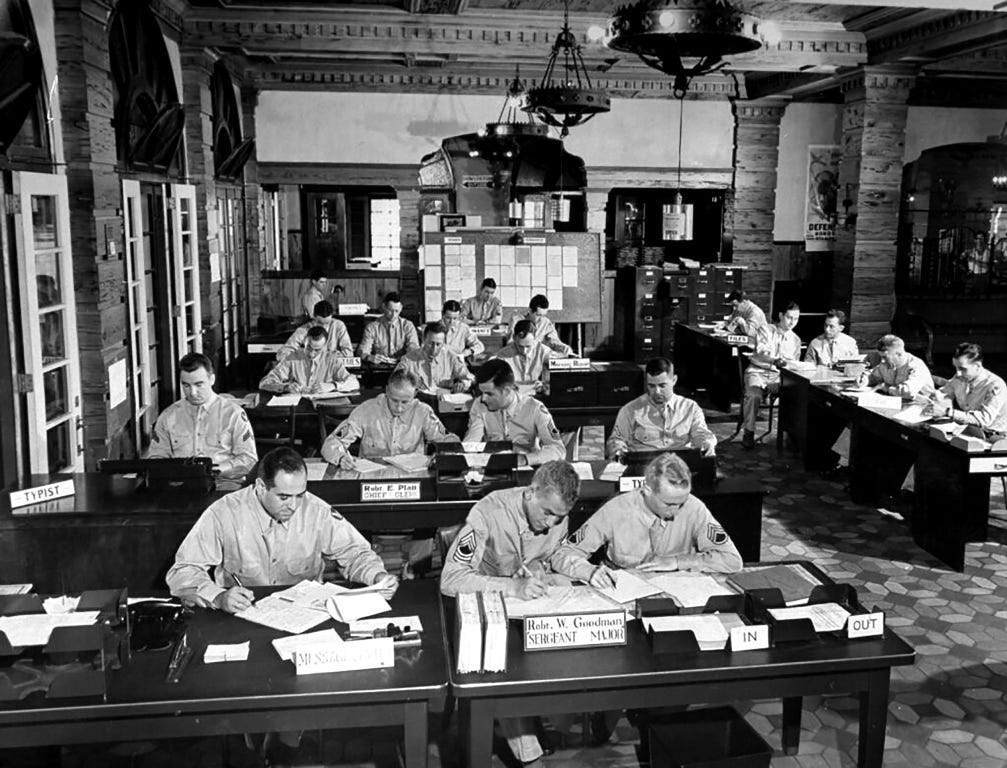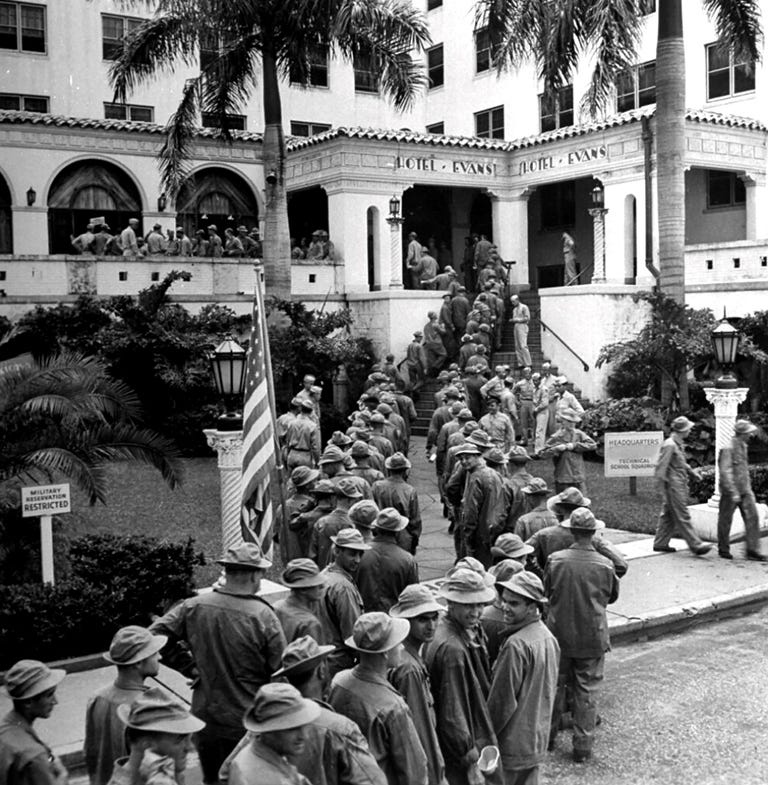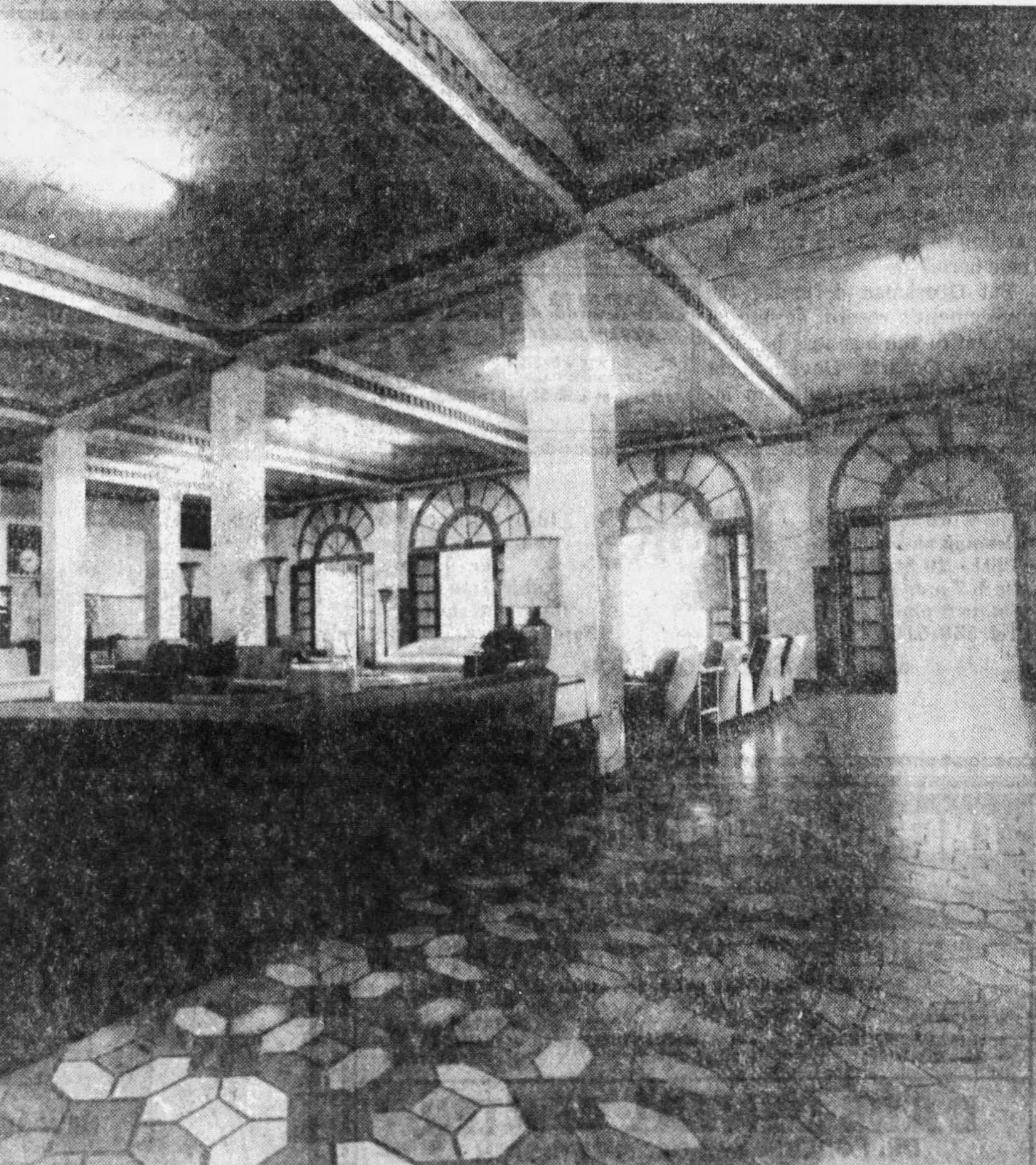Hotel Evans on Miami Beach
The history of Hotel Evans which was one of the first Jewish owned hostelries on Miami Beach when it opened in 1935, and served as the mess hall for the Army Air Corp during WWII.
There were many hotels constructed on Miami Beach during the mid to late 1930s at a time when South Florida was beginning to show signs of recovery after experiencing economic malaise during the Great Depression. Construction on Miami Beach during the Depression decade featured some of the beach’s most significant hotel and apartment buildings associated with the Art Deco movement.
Southeast Florida was also beginning to realize social progress as well. The area north of Fifth Street on Miami Beach was segregated from its inception in the 1910s through the early 1930s which meant only white patrons were allowed to stay in the hotels or purchase property on the beach. However, given economic conditions by the mid-1930s, there was a shift in attitude and composition of investors on the island after nearly a decade of difficult times.
Isadore Evans and family operated the Evans Hotel in the Catskills, and when they decided to open a second location, they chose the corner of Collins Avenue and Tenth Street on Miami Beach. The family was one of the earliest Jewish hoteliers on the beach in an area that once featured “Gentile Only” signs throughout the district. This is the story of Hotel Evans at 953 Collins Avenue on Miami Beach.
Announcement of New Hotel in February 1935
By the time Isadore Evans, his wife, and five sons made the decision to expand their operations to Miami Beach, they had already been in the hotel business for thirty-five-years. Their Hotel Evans in Loch Sheldrake, New York, was one of the largest and most popular summer resorts in the Catskill mountains and had a reputation as an upscale establishment that accepted and catered to Jewish clientele during a time of rampant discrimination against people of the Hebrew faith.
The announcement for the new hotel was published in the Miami Tribune on February 20, 1935, and provided details about the hotel and expected completion date. The Evans hired Harry J. Maloney as the architect to design a modern, first-class building to fit onto the corner lot which was 150 feet along Collins Avenue by 140 feet on Tenth Street.
The article went onto to describe the plans for the hotel as follows:
The building will be five stories in height, fireproof, of reinforced concrete construction. The ground floor will contain a grille, beauty and barber shops, valet room, bather’s lockers and showers for men and women, card and game rooms, children’s play room, as well as hotel rooms. A dining patio will be located on the 10th street side facing Collins Avenue. The lobby floor will contain a dining room, seating 250 people, kitchen, lounge and lobby, foyer, recreation and writing rooms, business office and manager’s private office. West of the dining room on the terrace will be provided another dining patio. The lobby floor will be elevated 11 feet above the finish grade.
According to the announcement, the project was to break ground on March 1, 1935, and be completed no later than October of the same year. While the project did begin on time, it took an extra couple of months before the hotel was ready for occupancy.
Formal Opening on December 8, 1935
Hotel Evans was finally ready for its formal opening on December 8, 1935. The 150-room hostelry opened with typical South Florida fanfare for this era featuring a formal dinner, orchestra, and dancing. The large dining room showcased high ceilings and side walls finished in polished pecky cypress, with rough knot holes providing a rustic tone. The predominant colors were gold and brown, with highlights of flame and copper color. The intent of the architect was to preserve a home-like atmosphere similar to the rest of the other common areas in the hotel. The chairs and tables in the dining room were metal in a soft, French gold finish, with flamed colored leather seats. The floor was a rust-colored tile, with the center of the room featuring a large area of terrazzo for the dance floor.
The hotel included several restaurants, including the bar and grill, which was operated by Herman’s of Atlantic City, and offered all day dining and special menus for breakfast, lunch, and dinner. During the winter seasons, the hotel offered nightly entertainment by their house orchestra. The Evans family paid particular attention to the quality of the cuisine when they entrusted Frank Laxer and his wife to oversee the menu and quality control of the main dining room on the lobby level. The Laxer family had a well-earned reputation for managing a varied menu and overseeing a well-run restaurant at a number of widely known hotels prior to taking over the main restaurant at Hotel Evans.
One feature of the hotel that garnered a lot of intrigue was the unusual entrance and porch of the hotel. A tile walkway, which leads from the corner of the lot, where Collins Avenue meets Tenth Street, diagonally to a long flight of steps, set at an angle across the front of the building, extended up to the long porch, where chairs and tables are available for the convenience of guests, and finally leading to a set of double doors which provided access to the lobby. The porch also included planters of tropical flowers and bushes around the entrance to provide a tropical motif for arriving guests.
As described in the announcement, the ground-level arcade included the bar and grill, a beauty and barber shop, card and game rooms, and the valet office. The ground level also afforded guests a changing room and shower for when they return from the beach, which was just one block to the east of the building. The hotel provided a service to lauder a guest’s beachwear and return it to their room within hours of them returning from the beach.
Design, construction and finishings were all done by local contractors. The project team was proud they could employ so many local workers to perform the labor needed to prepare the hotel for its formal opening. During a time of economic hardship, projects like constructing Hotel Evans were significant for the local economy.
Adam & Eve Solarium
When it opened in 1935, the top floor of Hotel Evans was leased to the Adam & Eve Solarium. This facility was both a gym and a place to sun bathe. Advertisements touted that this facility was one of the finest equipped and the largest solariums in South Florida.
The spa included nude sunbathing, Swedish massage, electric cabinet treatments, sun treatments, and Swedish gymnastics. It was staffed with 12 fully trained experts in the aforementioned treatments. Adam & Eve had additional spa locations in the Pancoast and Alamac Hotels on Miami Beach, and between the three locations, they were equipped to serve hundreds of patrons daily.
Living up to its description as a ‘solarium’, the facility emphasized the benefits of the sun. In an article in the Miami Herald, dated February 3, 1936, Adam Meister, owner of the solarium was quoted:
One of South Florida’s greatest assets is the sun with its marvelous rays. However, visitors should use care while exposed to the sun as harmful results may be had through ignorance of the strength of the sun’s rays. Sun rays relax the human body and while the body is being massaged, the circulation causes the sun rays to be more easily absorbed by the increased stimulation. At the Adam and Eve solariums we are able to produce a healthful looking tan in seven days of treatments, supervised by experts in this type of treatment.
The description of a 1930s era solarium can best be described as a gymnasium, which also offered spa treatment, along with supervised sun tanning. While it is unclear of the adoption of some of the services, the rooftop sun bathing was considered a big perk for hotel guests during the time period.
Heavyweight Boxing Champion a Guest
South Florida has always been enamored with celebrity visitors. During the first half of the last century, the most recognizable celebrities were generally the boxing champs, and none bigger than the heavyweight champion. From 1935 to 1937, the heavyweight champ was Jimmy Braddock, who was a friend of the Evans family.
Leading up to his first championship fight in 1935, Braddock trained at Hotel Evans in Loch Sheldrake, New York. It was there that he prepared for his fight with Max Baer. Braddock, his trainers, and sparring partners, as well as all the sports writers and photographers who watched his workouts, all were guests of Hotel Evans. The hotel prepared special menus for the fighter and his crew, and the team’s presence kept the guests and residents of nearby villages entertained. The hotel made special accommodations to provide everything the boxer needed to prepare for his big fight.
When the Miami Beach location opened for its inaugural winter season, Braddock made it a point to help promote the hotel by staying there in January of 1936. He signed autographs and took pictures in and around the hotel to bring attention to the resort. One of the photographs was taken with several greyhound dogs from the Miami Beach Kennel Club on the grounds of Hotel Evans (see Figure 4). The picture was published in newspapers around the country including the Miami News and Herald.
Remodeled in 1939
Although only four years old, the Evans family invested $50,000 to provide improvements to the appearance and equipment in the hotel. The interior common areas were repainted and redecorated, while new equipment was installed to replace the original finishings and appliances. The Bubble bar, patio, and ballroom, as well as the main Spanish dining room, lounges and lobbies were all refurbished.
Arthur Evans, one of Isadore’s sons, was the spokesman to announce the upgrades and changes. The family planned a colorful New Year’s Eve celebration to mark the fifth formal opening of the Spanish banquet room with a program of music and entertainment to welcome a new decade (1940). The banquet room was expanded to accommodate up to 500 persons, which was nearly double the occupancy of the original hall.
United States Army Air Corps in 1942
Following the United States entrance into World War II, South Florida became host to several branches of the military as training centers to prepare soldiers for battle. The Army Air Corps leased many of the hotels, apartments, restaurants, and other privately owned buildings throughout Miami Beach.
Hotel Evans had the grand banquet room and was one of the best candidates for becoming a large mess hall for the soldiers training on the beach. It was centrally located in relation to the hotels that were converted into barracks, and provided a good facility to feed the steady stream of soldiers as they prepared for their long day of training.
For two and half years, in addition to the banquet room becoming a mess hall, the Army converted common areas and meeting rooms into office space, and the 150 hotel rooms into barracks for enlistees being trained to become soldiers. By September of 1944, the Army returned the facility back to the private sector.
Hotel Sold and Renamed to Hotel Edward in 1944
Despite its use by the Army, the Evans decided to sell their Miami Beach hotel on September 14, 1944, for $420,000 to the Modern Brokerage Corp, a New York based investment firm headed by Dan Levenson. The new ownership group immediately changed the name to Hotel Edward and installed Edward Noulin as manager. In addition to the change in name and management, the dining room was taken over by Fan and Bill, which was a well-known steak house in New York.
At the time the transaction was finalized, the army still had a lease on the hotel but announced plans to return the hotel to civilian use by the end of September. After taking over the hostelry, Noulin brought in his staff from the Adirondack Inn and Beach Club at Sacandaga Park, New York, and began a complete rehabilitation of the hotel to prepare it for commercial use.
On May 1, 1945, Modern Brokerage leased the operation to Hotel Edwards Corp, a New York based management company, which turned over supervision to Irving Prince. The hotel continued to operate year-round and provided discounts to any member, or family member, of the armed forces. One of the modifications made by the new management company was a change of operation in the dining room. The Hickory House, run by Jack Goldman, replaced Fan and Bill’s steakhouse as the marquee restaurant in the hotel.
Illegal Gambling at Hotel Edward
Following the war, Hotel Edward resumed its role as a tourist destination to sun and fun seekers. One of the unspoken activities occurring in the hotel was an illegal gambling operation. In February of 1947, one of the hotel’s employees was arrested for possession of gambling equipment and ultimately fined $100 for his possession of the illegal paraphernalia. He was caught with a dice board at the time of his arrest.
A few years later, on January 17, 1951, the Hotel Edward was the first hotel raided as part of an undercover sting operation that targeted several Miami Beach hotels for running an illegal book operations out of their hotels. The officers posed as wealthy visitors staying at the hotel as they gathered evidence to raid the gambling operation in the hotel.
In total, there were three men arrested from Hotel Edward as part of the raid. However, there were never any grand jury indictments from the arrests, and two of the men filed lawsuits against Ex-Sheriff Thomas J. Kelly for $50,000 for damages stemming from their incarceration. Kelly was no longer the county sheriff at the time the lawsuit was filed.
Now Edward Apartments
By the late 1970s, Hotel Edward was in dire need of maintenance and upkeep. The Greater Miami Jewish Federation agreed to provide funding to help renovate the building as apartments and a social service facility for the Miami Beach retirement community. Ultimately, the property was sold to Harry N. Forman for $750,000 who invested an additional $325,000 to convert the hotel to apartments which provided subsidized housing for the retirees living on the beach during this era. It was at this time that the building was renamed to the Edward Apartments.
A few years after the conversion to an apartment complex, the television show ‘Miami Vice’ filmed a couple of scenes in the building during its run in the 1980s. One of the episodes, ‘The Mirror Image’, aired during season four, featured the Edward Apartments in several scenes throughout the episode.
The building was last sold to Gator Edwards Partners, headed by James Goldsmith of North Miami Beach, for $6 million in 2003, and still operates as the Edward Apartments today. During its 87-year-history, the Hotel Evans / Edward has seen a dramatic evolution of South Beach from the depression era through modern times. While it may not be obvious by looking at it today, the building has been a significant part of Miami Beach’s rich history.
Images:
Cover: Edward Apartments at 953 Collins Avenue in 2021. Courtesy of author.
Figure 1: Evans Hotel in Loch Sheldrake, New York. Courtesy of author.
Figure 2: Hotel Evans Rendering in 1935. Courtesy of Miami News.
Figure 3: Adam & Eve Solarium at top of Hotel Evans in 1935. Courtesy of Miami News.
Figure 4: Jimmy Braddock with Greyhounds at Hotel Evan in 1936. Courtesy of Miami News.
Figure 5: Army Personnel Working in Lobby of Hotel Evans in 1942. Courtesy of Life Magazine.
Figure 6: Soldiers Standing in Line for Mess Hall at Hotel Evans in 1942. Courtesy of Life Magazine.
Figure 7: Bookie Suspects Arrested at Hotel Edward on January 17, 1951. Courtesy of Miami Herald.
Figure 8: Lobby of Edwards Apartments in 1980. Courtesy of Miami News.





